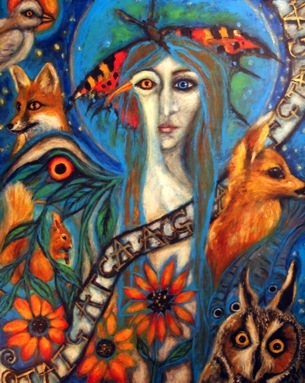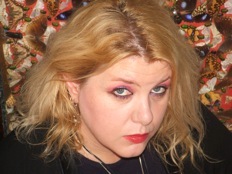THE HUMAN GENOME:
POEMS ON THE BOOK OF LIFE
GILLIAN K FERGUSON
THE HUMAN GENOME:
POEMS ON THE BOOK OF LIFE
GILLIAN K FERGUSON
Welcome



Welcome to ‘The Human Genome: Poems on the Book of Life’, the project for which Gillian K Ferguson won the £25,000 Creative Scotland Award, presented by the Scottish Arts Council.
A poetic exploration of the mapping of the human genetic code, the project takes the Human Genome - the entire genetic code of three billion letters required to create a human being – as its central creative motif. The mapping of the Human Genome has been hailed as the greatest intellectual achievement of mankind; more significant than splitting the atom or man’s landing on the Moon. Described as the ‘Holy Grail’ of biology, many consider it to be the greatest scientific breakthrough of all time. As well as being known as ‘the book of life’, it has also been called ‘the handwriting of God’, or ‘the human instruction book previously known only to God’. Indeed, it was the poetic language used by scientists and commentators to describe the Genome – not to mention talk of magic, mystery and miracle - that first drew the poet to the subject. And, by bringing an artistic vision to bear, Ferguson hopes to offer a ‘bridging’ - a way in to this fabulous science for those (many) without the academic qualifications in genetics. She believes the ethical implications are so profound, that we cannot afford to remain ignorant.
Four “obsessive” years in the making, this poetic exploration of the Human Genome encompasses 1000 pages – over four Sequences - of poems and poetic reflections interwoven with short extracts from interviews, academic papers, science websites, newspaper reports, poetry and books. Ranging from the mapping of the Genome and examination of the essence of its chemical ‘letters’, to the surrounding ethical issues and practical developments, the project also explores the Human Genome’s relation to areas such as religion, medicine, science, ecology and poetry. To reflect its interwoven ‘genomic’ nature, the project is presented here online as a ‘living’ work, inviting suggestions, ideas or extracts that might be further woven into the ‘genome’ of the project in the future.
A major focus of the project is ‘Comparative Genomics’, the study of the astounding genetic similarity being discovered among all living organisms on Earth – recent research shows, for instance, that human beings and mice share 99% genetic similarity. We even have the genes to make a tail! Creatures such as Puffer Fish, worms, rats and Fruit Flies are also being used as research models for human beings - to study illnesses and possible cures - due to our amazingly conserved similarities. Even the California purple sea urchin shares 7077 of its 23,300 genes with human beings. Birds and men share very similar genes affecting limb buds – perhaps explaining something of our fascination with flying and angels. Not to mention our preserved genetics with flowering plants and leaves – 75% of our genetic make-up is the same as a pumpkin…This increasingly revealed unity among all living creatures, spanning four billion years of Evolution and still preserved, incredibly, within the ‘writing’ of the Human Genome, is a central theme; along with our profound genetic connection with the threatened environment of planet Earth.
The project also looks significantly at the idea of the ‘Word’ in religion and the use of language metaphors in genetics; with the three billion ‘letters’ of the Genome commonly described as a ‘book’ – though the author finds it more akin to a poem - and genetic processes named ‘translation’, ‘transcription’ and so on. Ferguson suggests this shared metaphor of the ‘Word’ of life offers the possibility of a marriage of religion and science in the 21st century; she finds the idea of man coming from earth and water synthesises very nicely with cutting-edge genetic research. Though in the science narrative it does take four billion years…
The medical implications of the mapping of the Human Genome are staggering and the project explores this impact; along with cloning, stem cells, ‘pharming’, germline engineering, and other genetic breakthroughs. When the International Human Genome Sequencing Consortium finally completed the mapping of the Human Genome in 2003 – after 13 years of international effort – and published its description of the finished sequence in 2004, following the earlier ‘Draft’, it was the product of a 13-year collaborative effort to read the ‘Book of Life’. And the culmination of a desperate battle for the ‘soul’ of the Genome between the public and private sectors. The poet demonstrates the epic struggle to keep ‘the monument of mankind’ out of private hands - yet finds thousands of human genes are now being ‘patented’ by private companies. More battlegrounds are explored in the ‘sex wars’ carried out in the X and Y chromosomes – and this is related to questions of how the ‘feminine’ has been treated in science; including the consequences of the female identification of nature. The role of metaphor, vision and dream in science – and therefore how science has not always been ‘boxed off’ from all other aspects of thought as in the contemporary era - is also highlighted. Ferguson also sees the Genome as an opportunity for the coming together of the language and visions of the arts and science – particularly poetry - too long entirely separated, to the detriment of both.
More than anything, exploring the Human Genome through poetry and poetic reflection allows a new understanding, a new ‘illumination’ of this magnificent, epoch-changing – and genuinely staggering – achievement of 21st Century science. The Human Genome is, the poet believes, “a fantastic, beautiful poem; a magnificent work of Chemistry spanning four billion years of the art of Evolution” – now revealed in our time.
The Introduction offers a good guide to the full scope and evolution of the project; and there is also an invaluable ‘Primer’ at the start of Sequence One which introduces the Human Genome and explains some basic scientific terms. Divided into four ‘Sequences’, there is a natural ‘genomic’ feel to the work, with extracts related to the various aspects of the Human Genome interwoven with poems and poetic reflections. The Contents section allows navigation throughout the ‘genome’ of the whole project, or the navigation bar on the left hand side can also be used. To reflect its interwoven genomic nature, the project is intended as a ‘living’ work and the author invites suggestions for further additions, ideas or extracts.
Gillian K Ferguson is an award-winning poet, whose work has been described as dazzlingly original and boldly intelligent, combining vivid lyricism with an acute ‘Celtic’ sensibility to nature. She has an Honours degree in Philosophy, specialising in Metaphysics and Aesthetics. Her last book of poems was the ground-breaking ‘BABY’ - the first book of poems to chart the whole experience of becoming a mother. In a unique initiative with a high street chain, the book is now published by GAP and available in flagship BabyGAP stores (order a copy). Her Human Genome project continues to reflect the poet’s desire to reach people with poetry. She is also known as a witty, intelligent and compassionate newspaper columnist. (See more, About the Author).
A printed ‘Sampler’ of extracts from the project – ‘The Human Genome: Poems on the Book of Life’ – will soon be published; if you would like to be informed when it is available, please click here.
If you would like to use the poetic content of the project for any purpose, or wish to discuss anything in connection with the author, contact Gabriel Stanford.
Gillian Ferguson’s Human Genome project is presented to all readers free of charge and welcomes all readers. However, if you are in a position to contribute, and wish to make a donation to the poet’s future work, please click here.

'We're living in a time of extraordinary intellectual ferment, all centred round the great breakthroughs in science, both in physics and biology. The last time this happened so riotously, it provoked a great poetic reaction - Coleridge, Shelley and later Tennyson - yet this time, the response has been muted, small scale and more cautious. Where we have had poetry, and indeed drama and even opera, it has tended to focus on physics. Now Gillian Ferguson, with huge ambition, skill and daring, has showed what epic poetry can still do when confronted by the age of the genome, that universal four letter poem which beats any human achievement many million-fold. These are gorgeous, sinewy and darting poems, uncurling with great confidence and provide an excellent partner for the great prose writing of recent years, by E.O. Wilson, Dawkins, Matt Ridley, Daniel Dennett and many more.' Andrew Marr, Writer and Broadcaster
'‘These discussions are a really useful solvent, designed to melt away two very troublesome barriers - the barrier which, for many of us, shuts off Science from the rest of life, especially from poetry, and the still stiffer protective cordon thathas been set up to divide our species from the rest of nature. By exploring the rich imaginative flora that surrounds the idea of the Human Genome, Gillian Ferguson bypasses both these and opens a fine range of pathways through new and unsuspected territories. Good luck to her and to her fellow-travellers!’ Mary Midgley, Philosopher, and Author of 'Science and Poetry'
‘This project is truly awesome. A numinous tapestry of poems, quotes, and profound musings on life, science, God, and the genome…Thanks for the gift you are giving the world.’ Francis Collins, Head, United States Human Genome Project
‘Perhaps the most compelling fact surrounding the new science of the human genome is that letters, words - language itself - offer the clearest media through which both the scientific and the lay mind can begin to apprehend the inner secret of life. In making this the central metaphor of her extraordinary work, The Human Genome: Poems on the Book of Life, Gillian Ferguson takes poetry to extremes it has not encountered since the late work of Hugh MacDiarmid, or the ongoing work of Edwin Morgan. Her achievement brings art and science together in a challenging and exhilarating way. Vast ambition and its triumphant achievement.’ Richard Holloway, Chairman, Scottish Arts Council
‘The Human Genome deserves to be hymned by poets, and Gillian Ferguson may be its Homer.’ Matt Ridley, Science Correspondent, The Economist, Daily Telegraph; Author, Genome; The Autobiography of a Species in 23 Chapters, Fourth Estate
‘A vast celebration of the human genome - and a passionate declaration of the unity of life.’ Sir John Sulston, Leader, UK Human Genome Project
‘Any attempt to explore connections between scientific, artistic, and religious imagination is to be enthusiastically welcomed, for it is through multi-dimensional productive imagination that we discover the meaning of our world and ourselves. The Human Genome Poetry Project is to be applauded – it succeeds in bravely harmonising discourses and insights that are so often deemed to be at variance.’ John Cornwell, Director, Science and Human Dimension Project, Jesus College, Cambridge University


t
&
b
















